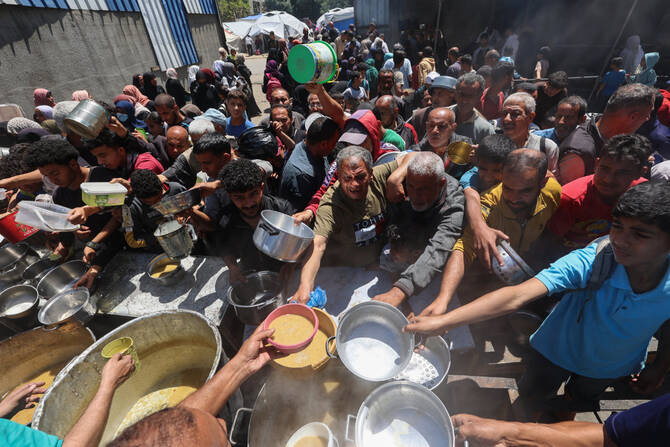
- ARAB NEWS
- 18 Aug 2025
レバノン経済は、地域が困難な状況に直面する中、継続中の武力紛争により縮小

RIYADH: Lebanon’s economy is expected to shrink by 1% in 2024 due to the severe impact of the armed conflict and the deepening political and economic crisis. However, a return to growth is still possible.
The European Bank for Reconstruction and Development’s (EBRD) latest report, Regional Economic Outlook, highlights that these factors have created an extremely volatile environment, and that the gross domestic product (GDP) growth outlook has deteriorated further due to stagnant reforms and lack of progress on International Monetary Fund (IMF) programs.
Inflation, which surged to a peak of 352% in March 2023, fell to 35.4% in July 2024. However, unemployment remains high, highlighting a serious socio-economic situation in which more than one-third of the workforce is unemployed.
“A return to moderate growth is possible in 2025 if reforms make some progress, IMF programs are implemented, and regional tensions are eased,” the EBRD report said, noting that a return to moderate growth is possible.
The passage of the 2024 Budget Act and the move of the exchange rate closer to the market rate have provided some stabilization, but Lebanon’s economy remains fragile.
Regional outlook for 2024 and beyond
According to the report, economic growth in the Southern and Eastern Mediterranean regions is expected to have a challenging year in 2024, with countries dealing with the impact of conflict, slowing investment, and disruptions caused by climate change.
Growth is projected to rise moderately to 2.1% in the first half of the year and 2.8% for the full year. This is a downward revision from the previous forecast, mainly due to a slower-than-expected recovery in investment in Egypt and ongoing conflicts in the Gaza Strip and Lebanon.
However, the outlook remains uncertain and depends on several factors, including the resolution of ongoing conflicts, the recovery of private and public investment, and an effective response to climate change.
Severe droughts in Morocco and Tunisia, as well as disruptions in the energy sector in Egypt, continue to pose significant risks to the region’s growth prospects.
The report emphasizes the need to continue reform and stabilization efforts across the SEMED region to ensure sustained economic growth over the coming years.
Egypt: Moderate Recovery Amid Energy Sector Turmoil
Egypt, the largest economy in the Middle East and North Africa, is projected to grow by 2.7 percent in the fiscal year ending June and rise to 4 percent in 2024-2025 as it continues to recover from prolonged economic hardship.
On a calendar year basis, growth is expected to be 3.2 percent in 2024 and 4.5 percent in 2025, indicating a steady recovery to pre-crisis levels, according to the EBRD.
Expansion in sectors such as retail, wholesale, agriculture, telecommunications, and real estate is driving the recovery.
However, the energy sector remains in turmoil, and while inflation is easing, it remains a challenge at 25.7% as of July, down from a peak of 38% in September 2023.
「2024年度(6月決算)の財政赤字はGDPの3.6%となり、GDPに対する債務比率は2025年度には83%に減少する見込みである」と報告書は述べている。
エジプトの外貨勘定は、3月の通貨切り下げ以降回復しており、外貨準備高は過去5年間で最高水準に達している。
また、国際パートナーや投資家からの資金流入も重要な支援となっている。しかし、特にエネルギー供給の混乱が継続していることや、IMFプログラムに基づく構造改革の遅れなど、リスクは依然として残っている。
ヨルダン:ガザ地区での戦争が経済見通しに重くのしかかる
ヨルダンの経済成長率は2024年には2.2%と、より緩やかなものになると予測されている。ガザ地区での紛争が継続していることで、観光業と投資の流れに著しい影響が出ている。
紛争により消費者の間に不確実性が高まり、大きな支出を控えるようになったことで、成長はさらに鈍化している。
EBRDは、地政学的な緊張緩和と経済改革の継続的な進展を条件として、2025年までに2.6%の成長率への緩やかな回復が可能であると述べた。
「ヨルダンの輸入への高い依存度は、同地域における地政学的な不安定さ、エネルギーや食料価格の急騰、世界的なサプライチェーンの混乱に対して脆弱であることを意味する」と報告書は説明している。
同国のインフレ率は7月時点で1.9%と依然として低水準にとどまっているが、失業率は21.4%と依然として高く、特に女性(34.7%)と若年層(43.7%)ではさらに高い。
ヨルダン中央銀行は、通貨ペッグ制を維持するための取り組みの一環として、米国連邦準備制度に倣い、政策金利を安定させてきた。
モロッコ:干ばつによる農業の苦境と観光業の回復
モロッコは深刻な干ばつに苦しんでおり、同国の経済の主要な推進力である農業生産に影響が出ている。
欧州復興開発銀行(EBRD)は、製造業と観光業の回復を原動力として、2024年には2.9%、2025年には3.6%の成長が見込まれると予測している。
7月に1.3%まで低下したインフレ率の緩和は、いくらか安心感をもたらしている。輸出と国内需要は引き続き経済活動を支えている。
モロッコ政府は財政健全化策に着手しており、2023年の財政赤字はGDPの4.3%まで減少する見通しである。天候が回復し、農業生産が回復すれば、2025年の見通しはさらに明るくなるだろう。
エネルギー輸入への依存と気候変動による脆弱性により、モロッコには依然として下方リスクが存在する。
深刻な干ばつは短期的には成長の重しとなることが予想されるが、観光、送金、自動車および電気製品の輸出の回復が、緩やかな成長を持続させるだろう。
トルコの経済が正統派へシフト
2023年には、トルコはより伝統的な経済政策に戻り、インフレ対策として金融および財政措置を強化した。
中央銀行は政策金利を4.15%引き上げ50%とし、財務省の効率化パッケージは、震災関連費用を除く財政赤字の削減を目指した。
7月に予定されていた最低賃金の引き上げを見送る決定は、インフレ期待の安定化に役立った。
金融活動作業部会(FATF)のグレー・リストからトルコが除外されたことで、投資家の信頼感は改善し、クレジット・デフォルト・スワップ(CDS)保険料の低下やソブリン債格付けの引き上げがそれを示している。7月の経常赤字は191億ドルに縮小し、一方で外貨準備高は1479億ドルに増加した。
2024年の上半期の経済成長率は3.8%で、前年の4.6%から減少した。製造業の減速にもかかわらず、民間消費は依然として成長を牽引している。
年間のインフレ率は、5月のピーク時の75.4%から8月には52%に低下したが、年末までに41.5%に修正されたインフレ目標を達成するには、引き続き金融引き締め政策が必要である。
経済成長率は、高インフレと地政学的な緊張によるリスクがある中で、2024年には2.7%に低下すると予測されている。
チュニジア:緩やかな成長だが財政難は継続
チュニジア経済は2024年に1.2%の緩やかな成長を遂げ、2025年には1.8%にわずかに上昇すると予測されている。
7月時点でインフレ率は30か月ぶりの低水準となる7%に減少しているが、同国は依然として重大な経済的課題に直面している。報告書によると、その課題には、巨額の対外債務負担、限られた財政余地、外部からの衝撃に対する脆弱性などが含まれる。
農業と鉱業の縮小にもかかわらず、チュニジアでは観光業、金融サービス、その他の産業部門が成長し、経済をある程度支えている。
チュニジアの財政難は、経常収支の赤字の改善と税収の増加により、いくらか緩和されている。
しかし、外部資金への依存とIMF支援プログラムの遅々とした進展は、依然として経済の安定に大きなリスクをもたらしている。






















